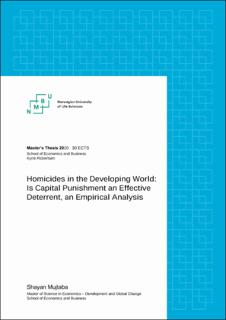| dc.contributor.advisor | Rickertsen, Kyrre | |
| dc.contributor.advisor | Holden, Stein | |
| dc.contributor.author | Mujtaba, Shayan | |
| dc.date.accessioned | 2020-09-24T14:12:22Z | |
| dc.date.available | 2020-09-24T14:12:22Z | |
| dc.date.issued | 2020 | |
| dc.identifier.uri | https://hdl.handle.net/11250/2679538 | |
| dc.description.abstract | This study uses a panel data on 24 developing countries across four continents Africa, Americas, Asia and Europe on homicide rates for a period of 12 years from 2001-2012. Data for the analysis were taken from different sources such as the World Bank, United Nations Office on Drugs and Crime, Amnesty International, World Inequality Database (WID) and the World Health Organization (WHO). I have used Becker (1968) model based on the Rational Choice Theory (RCT) for selecting my variables that explain the incidence of crime. Becker (1968) suggests that criminals act rationally and base their decision to commit a crime on a cost-benefit analysis. I use the Hausman test to verify which model, fixed or random effects best fits my econometric equation for homicide rates and measure deterrent effects of capital punishment. The results suggest that homicide rates tend to increase with increased economic activity while human development index (HDI) plays a highly significant role on the impact of homicide. Higher the human development index score, the lesser the degree of homicide. Higher economic growth shows two distinct results; Higher real GDP growth leads a reduction in homicide rates while the increase in GDP per capita (US$) leads to an increase in homicides.
The Hausman test suggests a random effects model is better suited for my analysis rather than a fixed effects model as it also considers, the time invariant variables. Lastly, as normal intuition might suggest, capital punishment does have a deterrent effect on homicides; meaning it reduces the homicide rates and enforces the offender not to commit murder. But it proves to be statistically insignificant, suggesting it is an inadequate measure in reducing homicide rates and a better alternative policy is required. | en_US |
| dc.language.iso | eng | en_US |
| dc.publisher | Norwegian University of Life Sciences, Ås | en_US |
| dc.rights | Navngivelse-DelPåSammeVilkår 4.0 Internasjonal | * |
| dc.rights.uri | http://creativecommons.org/licenses/by-sa/4.0/deed.no | * |
| dc.subject | Crime | en_US |
| dc.subject | Human development | en_US |
| dc.title | Homicides in the developing world : is capital punishment an effective deterrent? : an empirical analysis | en_US |
| dc.type | Master thesis | en_US |
| dc.subject.nsi | VDP::Social science: 200::Economics: 210::Economics: 212 | en_US |
| dc.description.localcode | M-ECON | en_US |

